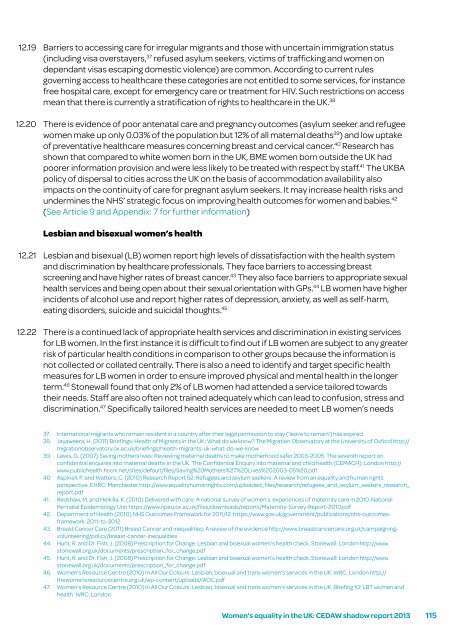Women’s equality in the UK – A health check
Women’s equality in the UK – A health check
Women’s equality in the UK – A health check
You also want an ePaper? Increase the reach of your titles
YUMPU automatically turns print PDFs into web optimized ePapers that Google loves.
12.19<br />
12.20<br />
12.21<br />
12.22<br />
Barriers to access<strong>in</strong>g care for irregular migrants and those with uncerta<strong>in</strong> immigration status<br />
(<strong>in</strong>clud<strong>in</strong>g visa overstayers, 37 refused asylum seekers, victims of traffick<strong>in</strong>g and women on<br />
dependant visas escap<strong>in</strong>g domestic violence) are common. Accord<strong>in</strong>g to current rules<br />
govern<strong>in</strong>g access to <strong>health</strong>care <strong>the</strong>se categories are not entitled to some services, for <strong>in</strong>stance<br />
free hospital care, except for emergency care or treatment for HIV. Such restrictions on access<br />
mean that <strong>the</strong>re is currently a stratification of rights to <strong>health</strong>care <strong>in</strong> <strong>the</strong> <strong>UK</strong>. 38<br />
There is evidence of poor antenatal care and pregnancy outcomes (asylum seeker and refugee<br />
women make up only 0.03% of <strong>the</strong> population but 12% of all maternal deaths 39 ) and low uptake<br />
of preventative <strong>health</strong>care measures concern<strong>in</strong>g breast and cervical cancer. 40 Research has<br />
shown that compared to white women born <strong>in</strong> <strong>the</strong> <strong>UK</strong>, BME women born outside <strong>the</strong> <strong>UK</strong> had<br />
poorer <strong>in</strong>formation provision and were less likely to be treated with respect by staff. 41 The <strong>UK</strong>BA<br />
policy of dispersal to cities across <strong>the</strong> <strong>UK</strong> on <strong>the</strong> basis of accommodation availability also<br />
impacts on <strong>the</strong> cont<strong>in</strong>uity of care for pregnant asylum seekers. It may <strong>in</strong>crease <strong>health</strong> risks and<br />
underm<strong>in</strong>es <strong>the</strong> NHS’ strategic focus on improv<strong>in</strong>g <strong>health</strong> outcomes for women and babies. 42<br />
(See Article 9 and Appendix: 7 for fur<strong>the</strong>r <strong>in</strong>formation)<br />
Lesbian and bisexual women’s <strong>health</strong><br />
Lesbian and bisexual (LB) women report high levels of dissatisfaction with <strong>the</strong> <strong>health</strong> system<br />
and discrim<strong>in</strong>ation by <strong>health</strong>care professionals. They face barriers to access<strong>in</strong>g breast<br />
screen<strong>in</strong>g and have higher rates of breast cancer. 43 They also face barriers to appropriate sexual<br />
<strong>health</strong> services and be<strong>in</strong>g open about <strong>the</strong>ir sexual orientation with GPs. 44 LB women have higher<br />
<strong>in</strong>cidents of alcohol use and report higher rates of depression, anxiety, as well as self-harm,<br />
eat<strong>in</strong>g disorders, suicide and suicidal thoughts. 45<br />
There is a cont<strong>in</strong>ued lack of appropriate <strong>health</strong> services and discrim<strong>in</strong>ation <strong>in</strong> exist<strong>in</strong>g services<br />
for LB women. In <strong>the</strong> first <strong>in</strong>stance it is difficult to f<strong>in</strong>d out if LB women are subject to any greater<br />
risk of particular <strong>health</strong> conditions <strong>in</strong> comparison to o<strong>the</strong>r groups because <strong>the</strong> <strong>in</strong>formation is<br />
not collected or collated centrally. There is also a need to identify and target specific <strong>health</strong><br />
measures for LB women <strong>in</strong> order to ensure improved physical and mental <strong>health</strong> <strong>in</strong> <strong>the</strong> longer<br />
term. 46 Stonewall found that only 2% of LB women had attended a service tailored towards<br />
<strong>the</strong>ir needs. Staff are also often not tra<strong>in</strong>ed adequately which can lead to confusion, stress and<br />
discrim<strong>in</strong>ation. 47 Specifically tailored <strong>health</strong> services are needed to meet LB women’s needs<br />
37. International migrants who rema<strong>in</strong> resident <strong>in</strong> a country after <strong>the</strong>ir legal permission to stay (‘leave to rema<strong>in</strong>’) has expired.<br />
38. Jayaweera, H. (2011) Brief<strong>in</strong>gs: Health of Migrants <strong>in</strong> <strong>the</strong> <strong>UK</strong>: What do we know? The Migration Observatory at <strong>the</strong> University of Oxford http://<br />
migrationobservatory.ox.ac.uk/brief<strong>in</strong>gs/<strong>health</strong>-migrants-uk-what-do-we-know<br />
39. Lewis, G. (2007) Sav<strong>in</strong>g mo<strong>the</strong>rs lives: Review<strong>in</strong>g maternal deaths to make mo<strong>the</strong>rhood safer 2003-2005. The seventh report on<br />
confidential enquires <strong>in</strong>to maternal deaths <strong>in</strong> <strong>the</strong> <strong>UK</strong>. The Confidential Enquiry <strong>in</strong>to maternal and child <strong>health</strong> (CEMACH): London http://<br />
www.public<strong>health</strong>.hscni.net/sites/default/files/Sav<strong>in</strong>g%20Mo<strong>the</strong>rs%27%20Lives%202003-05%20.pdf<br />
40. Asp<strong>in</strong>all, P. and Watters, C. (2010) Research Report 52: Refugees and asylum seekers: A review from an <strong>equality</strong> and human rights<br />
perspective. EHRC: Manchester http://www.<strong>equality</strong>humanrights.com/uploaded_files/research/refugees_and_asylum_seekers_research_<br />
report.pdf<br />
41. Redshaw, M. and Heikilla, K. (2010) Delivered with care: A national survey of women’s experiences of maternity care <strong>in</strong> 2010. National<br />
Per<strong>in</strong>atal Epidemiology Unit https://www.npeu.ox.ac.uk/files/downloads/reports/Maternity-Survey-Report-2010.pdf<br />
42. Department of Health (2010) NHS Outcomes Framework for 2011/12. https://www.gov.uk/government/publications/nhs-outcomesframework-2011-to-2012<br />
43. Breast Cancer Care (2011) Breast Cancer and <strong>in</strong>equalities: A review of <strong>the</strong> evidence http://www.breastcancercare.org.uk/campaign<strong>in</strong>gvolunteer<strong>in</strong>g/policy/breast-cancer-<strong>in</strong>equalities<br />
44. Hunt, R. and Dr. Fish, J. (2008) Prescription for Change: Lesbian and bisexual women’s <strong>health</strong> <strong>check</strong>. Stonewall: London http://www.<br />
stonewall.org.uk/documents/prescription_for_change.pdf<br />
45. Hunt, R. and Dr. Fish, J. (2008) Prescription for Change: Lesbian and bisexual women’s <strong>health</strong> <strong>check</strong>. Stonewall: London http://www.<br />
stonewall.org.uk/documents/prescription_for_change.pdf<br />
46. <strong>Women’s</strong> Resource Centre (2010) In All Our Colours: Lesbian, bisexual and trans women’s services <strong>in</strong> <strong>the</strong> <strong>UK</strong>. WRC: London http://<br />
<strong>the</strong>womensresourcecentre.org.uk/wp-content/uploads/IAOC.pdf<br />
47. <strong>Women’s</strong> Resource Centre (2010) In All Our Colours: Lesbian, bisexual and trans women’s services <strong>in</strong> <strong>the</strong> <strong>UK</strong>. Brief<strong>in</strong>g 10: LBT women and<br />
<strong>health</strong>. WRC: London<br />
<strong>Women’s</strong> <strong>equality</strong> <strong>in</strong> <strong>the</strong> <strong>UK</strong>: CEDAW shadow report 2013 115


